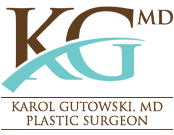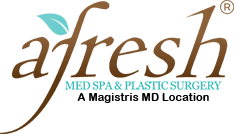Sagging breasts can be improved. Learn about a breast lift before you meet Dr Gutowski in person.
TRANSCRIPTION
Over time a woman’s breasts may lose their youthful shape and firmness, resulting in sagging breasts with a flattened, elongated shape and a nipple and an areola pointed downward. These changes may result following pregnancy, breastfeeding or weight loss or due to aging and the effects of gravity and heredity.
Breast lift, called Mastopexy, can restore firmness in a more youthful, uplifted shape to a woman’s breasts by surgically removing excess skin and tightening breast tissue. Mastopexy can also reduce the size of an areola, the dark skin surrounding the nipple, that can become enlarged over time due to sagging breasts and stretched skin.
The result is a more firm, rounded breast with natural projection and a more youthful position. Breast lift alone does not increase breast size, however, it can be performed in conjunction with breast augmentation, the surgical placement of breast implants to enhance breast size. In addition to improving the position and shape of sagging breasts.
This program presents an overview of breast lift. It is not a substitute for a complete consultation with a plastic surgeon certified by the American Board of Plastic Surgery or the Royal College of Physicians and Surgeons of Canada. A woman of any age, who’s breast development is stable and who is of stable weight, can be a good candidate for breast lift.
The changes to a woman’s breasts following weight loss and the changes that result following pregnancy and breastfeeding may diminish the result of a breast lift. Therefore, if you are planning future weight loss or pregnancies, you may wish to postpone your breast lift. In addition, good candidates for breast lift are healthy individuals who do not have life-threatening illnesses or medical conditions that can impair healing.
A consultation with a board certified plastic surgeon and member of the American Society of Plastic Surgeons, who may also be a member of the American Society for Aesthetic Plastic Surgery, is the first step to learn how breast lift can enhance breast appearance and improve your body image. A consultation is designed to fully educate you about breast lift, with a discussion of your goals, the options available in breast lift surgery, the likely outcomes of breast lift surgery and potential risks and complications.
Your surgeon will also describe the course of treatment recommended for you and answer your questions. During a consultation, you will be asked to share your expectations for breast lift and your personal health history. Full disclosure of your health history is important to your safety. This includes any history of breast cancer in your family and your personal breast health. You must also be candid about current medications you may be taking, the use of vitamins and herbal supplements and alcohol, tobacco and drug use.
By making the decision to consult with a board certified plastic surgeon and following all of the instructions you are given, you are taking an important step to helping assure your safety. A board-certified plastic surgeon is a physician who is specifically trained in plastic surgery of the face and entire body. Prior to your procedure, you will be asked to sign informed consent documents. These documents ensure your plastic surgeon, that you fully understand the procedure you will undergo and potential risks and complications.
In addition, you must commit to precisely following all of the instructions you are given. Instructions include presurgical considerations, such as testing and medications, day of surgery instructions and medications and specific information related to the use of anesthesia. A mammogram may be recommended prior to your procedure, to ensure breast health and serve as a baseline for future comparison.
Breast lift is generally performed on an outpatient basis, in an office-based surgical facility, an ambulatory surgical center or hospital setting. Members of the American Society of Plastic Surgeons and the American Society for Aesthetic Plastic Surgery, are required to use only accredited surgical facilities. Local anesthesia with sedation or general anesthesia is required.
The technique and incision pattern recommended for your breast lift will be based on your breast size and shape, the size and position of your areola and the degree of breast sagging you have. As well as the skin elasticity and the amount of excess skin that will be removed. Incision patterns have many variations that may include all or a combination of an incision around the areola, vertically down from the areola to the breast crease and horizontally near the breast crease.
Through these incisions, the underlying breast tissue is lifted and reshaped. The nipple and areola are repositioned to a more natural, youthful height and if desired, an enlarged areola is reduced by excising skin at the perimeter. Excess skin is then removed and the remaining skin tightened, as the incisions are closed with sutures, skin adhesives and or surgical tape.
In general, complications from plastic surgery of the breast include bleeding, poor healing at the incision sites, thick, discolored or raised scars, changes in nipple sensation and infection. Women who smoke are at increased risk of poor healing and are therefore advised to stop smoking for several weeks before and after surgery.
Breast lift surgery does not generally interfere with a woman’s future ability to breastfeed. Immediately following your breast lift surgery, dressings or bandages may be applied to your incisions and an elastic bandage or support bra will minimize swelling and support the breasts as they heal. A small, thin tube may be temporarily placed under the skin to drain any excess blood that may collect.
Before being released, you and an accompanying family member, friend or caregiver will be given specific instructions that may include how to care for the breasts following surgery, medications to apply or take orally to aid healing and reduce the risk of infection. Specific changes to watch for at the surgical site or in overall health and when to follow up with your plastic surgeon.
In general, your recovery from plastic surgery of the breast may include swelling and discomfort at the incision sites and in breast tissue overall. Discomfort is common and can be controlled with medication. You should begin light walking as soon as possible following your breast surgery. In addition a support bra may be recommended for the first week or two following breast surgery.
Initial wound healing may take one to two weeks, at which time any sutures will be removed if necessary. The initial results of breast lift are visible immediately. You should be able to return to work or normal activity within a week following breast lift if you feel ready, but do not engage in any heavy lifting or vigorous exercise until your plastic surgeon gives you clearance to do so.
Intimate contact with the breasts and more vigorous exercise may resume when healing is more fully completed, usually within four to six weeks following breast lift surgery. Healing will continue for several weeks as swelling resolves and breast shape and positions settle. Your incision lines will continue to fade over the next year or more. Even though incisions are placed inconspicuously, incision lines will result in permanent scars.
Breast lift is a highly satisfying plastic surgery procedure, to improve the shape and position of a woman’s breasts. Over time your breasts will continue to change due to aging, weight fluctuations, hormonal factors, and gravity. However, your new enhanced breast shape and body contour will give you the confidence and freedom to wear certain clothing styles including swimsuits.
Your results are best maintained by a stable weight, a healthy lifestyle and proper support of your now firm and rejuvenated breasts. Choosing to undergo breast lift or any plastic surgery procedure, whether cosmetic or reconstructive, is an important decision, so is selecting a plastic surgeon. The American Society of Plastic Surgeons and the American Society for Aesthetic Plastic Surgery have prepared this educational program.
To supplement your personal consultation with a plastic surgeon, who is certified by the American Board of Plastic Surgery or the Royal College of Physicians and Surgeons of Canada. Plastic surgeons with this certification have completed approved surgical training and rigorous examinations in plastic surgery, including both cosmetic and reconstructive procedures of the face and entire body.









